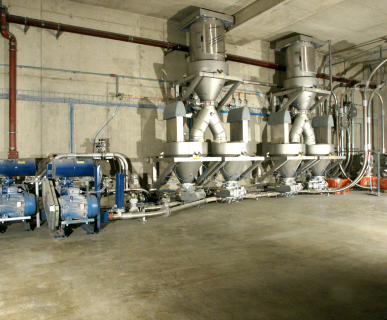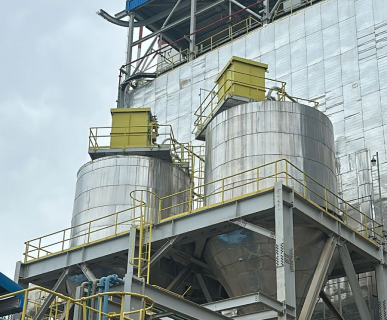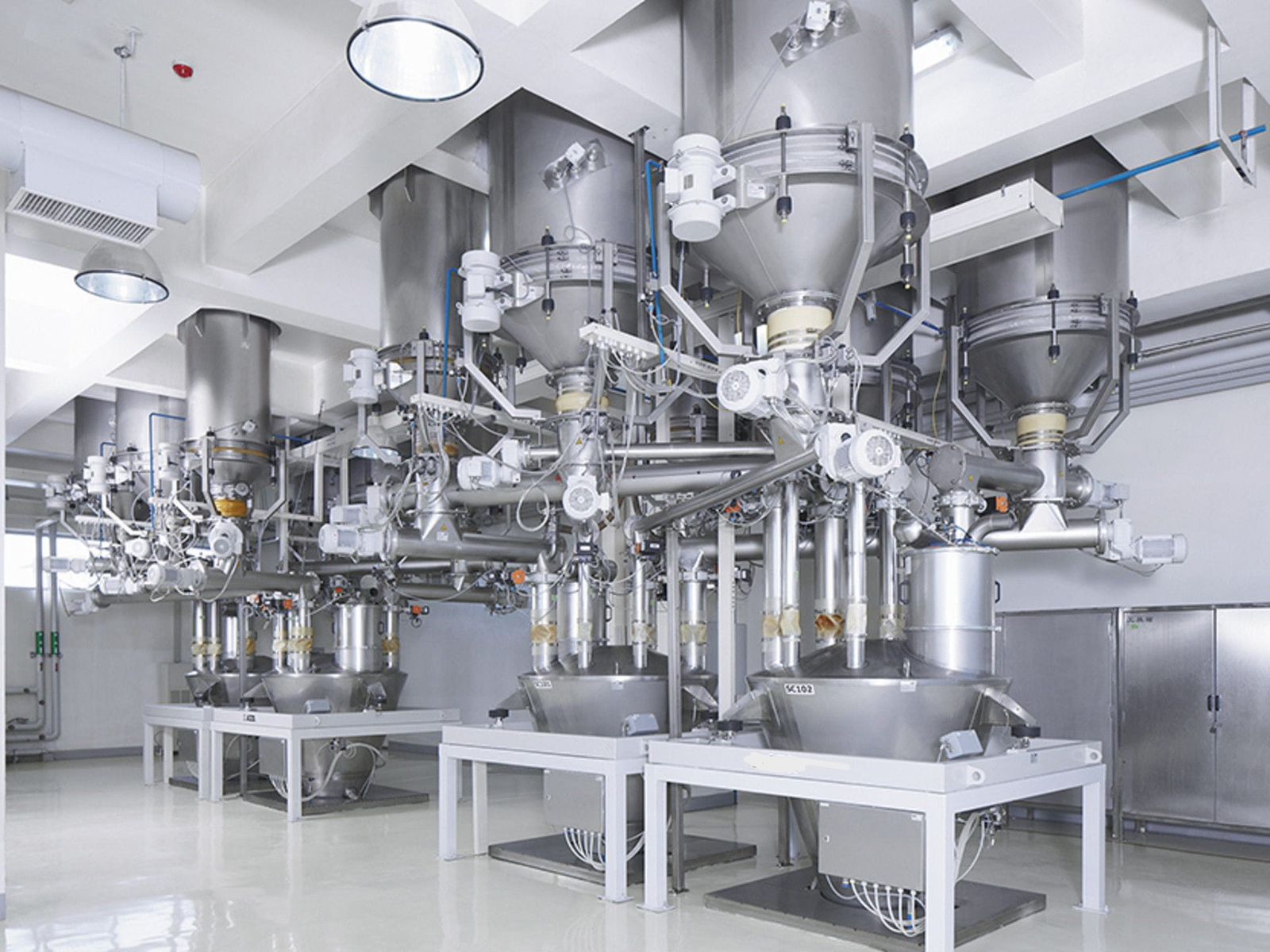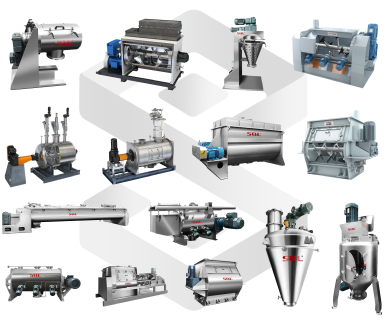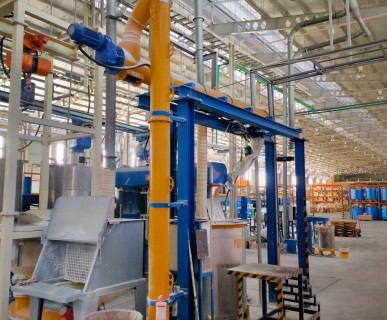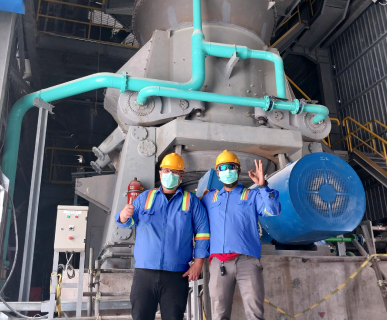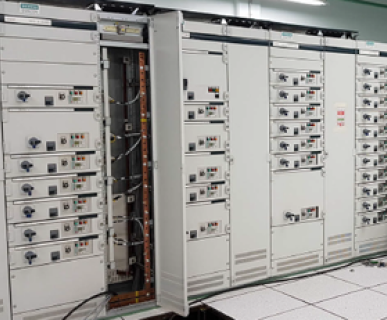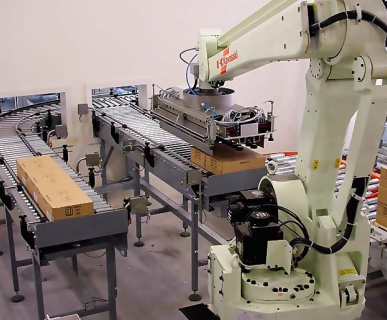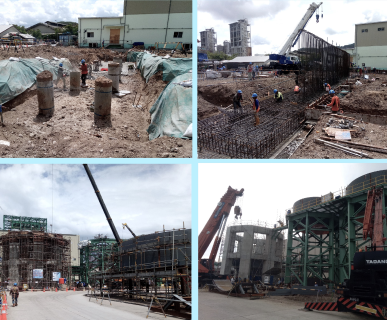Conventional dense phase – high pressure, lower velocities than typical dilute phase, but without “Air Assist Technology”
Dense phase with Air Assist-Lower pressure than conventional than conventional dense resulting in lower velocities and overall energy.
Dense phase vacuum conveying systems are designed to convey fragile materials at low velocities.
Probably one of the most commonly used concepts for conveying of bulk solids. Typical dilute phase pressure system where material is entrained in air stream which much be greater than the saltation velocity of the material.
Typical dilute phase vacuum system where material is entrained in the air stream which must be greater than the saltation velocity of the material.
Product is entrained in air stream, as in conventional dilute phase pressure system.
The booster allows for the introduction of air into the pipes which are designated to transport material in order to make a homogeneous trajectory. The use of boosters enables a high level of efficiency during transport and a reduction of air consumption.
They are placed along the pipes to direct the flow of material in two or three different directions. It has an oscillating tube for fully automatic movements in any position. They pneumatic diverter valves are available in sizes from 2” to 8”. As special diverter version is also available.
The air gravity conveyors allow the exit of the material in a non-vertical straight tract taking advantage of the force of gravity.
We design and fabricate or procure a common mechanical conveying system like belt conveyor, tripper conveyor, bucket elevator, tube conveyor, vibratory tubular conveyor, chain conveyor, screw conveyor, rotary airlock, vibratory feeder, and apron feeder.
The SIP range of dust extraction system has been designed with a focus on operating parameters such as optimal air handling, superior filter cleaning and excellent collection efficiency.
Safety and Maintenance issues were also a priority. To improve the design further we encouraged feedback from our customers and the input of our maintenance departments as well. The design incorporates this feedback as well as all current occupational health and safety issues.
Minimum cost of ownership for our customers was also a design criteria. This included being able to use the least skilled labor to perform any given task and to provide a filter that will last many years.
From the plastics in your smart phone to the fertilizer used to grow the fruits and vegetables you eat every day, dry bulk solids are the building blocks for many of the items that shape the world around us. The industries that create these products (the fertilizers, the plastics, the food products, the building supplies) all have the drive and desire to make their processes more efficient, more cost effective, and more reliable. The most effective way of accomplishing these goals is to understand what is occurring within a process so that it can be optimized. Ideally, that means measuring the input and output of each minor process in order to understand, for instance, the optimal setting for each piece of machinery, the best ratio for mixing ingredients, the best way of maximizing output while minimizing cost. Because dry bulk solids are such an important part of many of the products around us, being able to accurately measure them is critical to the efficiency of their production. The question, then, is “How do you measure dry bulk solids accurately?” The simple answer is “Don’t measure them inaccurately!”
Some of the most common causes of
inaccurate bulk solids flow
measurement include:
• An improper selection of
measurement technology
• Measurement assumptions regarding
key variables
• Inadequate space for installation
• Product that collects, builds up,
or sticks to the measurement element
• Highly mechanical components that
become unreliable due to wear
Choosing the Correct Measurement Technology There are many ways of measuring solids flow, and picking the correct flow measurement device is crucial to the success of any flow measurement application. The flow meter you choose greatly depends on what your requirements for the flow measurement are (including the accuracy requirement) and where within your process you would like to perform the measurement.
For the measurement of flow being pneumatically conveyed, there are a variety of non-intrusive flow meter styles that use radar, Doppler, or nuclear technologies in order to calculate mass flow. These meter styles are non-intrusive, meaning that the measurement element does not penetrate into the flow stream. Their non-intrusive style makes these types of meters versatile. However, in certain circumstances, they can be quite inaccurate as well.
For static product that is no longer in process (product in silos, trucks, railcars, etc.), static weigh scales or truck scales are certainly an option as they can be quite accurate. Static weigh scales are somewhat limited in their application however, as the process must halt completely during the measurement cycle and often, the measurement is only performed after product has been emptied into the measurement vessel (silo, railcar, truck, etc.), making overfilling a distinct concern.
As an alternative to the use of static weigh scales, dynamic flow meters measure the flow of product in-process. In the case of filling silos, trucks, or railcars, dynamic flow meters can measure the product as the fill is occurring, not afterwards which allows for better control of the fill and mitigates the effects of over filling and under filling.
Dynamic flow meters are great for filling applications, but also for a variety of other applications, ranging from short batching applications to continuous blending operations and everything in between. Coriolis meters are one type of dynamic flow meter that utilizes spinning mechanisms that change torque as product passes through it. This change in torque is then processed as mass flow. Coriolis based mass flow meters are generally quite accurate. However, special attention to maintenance and wear are required when utilizing these devices as they are highly mechanical in nature. As with all mechanical devices, continuous use without preventative maintenance and repair could lead to the damage of key components. Furthermore, if the rotating mechanism fails on some Coriolis-style meters, they will not allow product to flow through them, which means that if the meter does not have a bypass system, production could cease.
Another group of dynamic flow meters utilize a gravimetric method of measuring flow. Gravimetric flow meters are typically accurate and dependable flow meters that allow for an actual, real-time measurement of flow rather than a calculation based on assumed values for key components such as density, shape, or particle size. One type of gravimetric flow meter used for measuring small batches of product is the loss-in-weight meter which typically offers a reliable and accurate measurement. These loss-in-weight measurement devices utilize a vessel on load cells and as product is drawn out of the vessel, the load cells detect the difference, or loss, in weight in order to deduce mass flow. Because loss-in-weight devices experience measurement "blind spots" as the vessel is being filled with product, loss-in-weight measurement tends to be much more accurate for very low flow rates and for shorter batching runs where the hopper will not need to be refilled during a batching cycle.
For larger batches or for continuous processes, belt scales or weigh belts can be used as they do not experience measurement blind spots. Weigh belts and belt scales utilize a belt conveyor in conjunction with load cells in order to measure the amount of product passing over the belt. Because the belt’s speed is integral to the measurement of mass flow, the belt’s tension is critical to the flow meter’s accuracy. Many things can affect the belt’s tension including changes in temperature and even normal wear. Thus, belt scales and weigh belts often require calibration checks to verify their calibration. Because they are highly mechanical in nature, these types of flow meters may require frequent replacement of parts or repairs and so maintenance costs can be high as well.
Some of the most accurate and versatile gravimetric style flow meters utilize a measurement that is based on centripetal force. As product slides across a curved measurement surface, the circular motion of the particles generates a centripetal force that is proportional to mass flow. As long as product is able to slide across the measurement surface, these types of meters are extremely accurate and the accuracy is typically not affected by the type of product that is being measured (granular, powdery, bulky lightweight materials, heavy dense materials, etc.). These meters typically have a small vertical footprint, can be installed nearly anywhere in a process, and are a great choice for nearly any “in process” installation where accuracy is paramount.
Choosing the correct measurement technology is crucial to the success of any flow measurement installation. Knowing where you want to measure product and how you intend to use the data offered by the flow meter is critical to the meter’s success. Know your process and know what each type of flow meter can bring to your particular application. It is also important to know the full cost of any flow measurement system. While the upfront cost of a flow meter may be quite low, low accuracy or high maintenance costs can make a “cheap” meter very expensive. Conversely, a seemingly expensive meter may be extremely accurate and have extremely low maintenance and repair costs and so may actually be quite inexpensive in the long run.
Vertical Ribbon Mixer consists of cone & vertical shape vessel body, drive unit, helical blades and chopper. The mixing blade is designed for three-dimensional movement of materials to create helical material upwards flow along the periphery of vessel and gravity downward flow in the center at optimum mixing quality. During this continuous operation, material particles and heat are exchanged quickly which leads to a homogeneous product. Besides, the material particles are mixed with minimal mechanical and thermal stress, which makes this type of mixer a good solution for fragile and heat sensitive product. Vertical Blender can promise perfect mixing homogeneity, even big wide range mixing ratio and complete discharge without any dead space. Multi functions can also be achieved to perform uniform, fast and contamination-free dry powder mixing, drying, evaporation, heat treatment, reactions, cooling or dosage of active ingredients in a single unit.
Conical Screw Mixer, also famous known as Nauta Mixer, consists of a conical shape vessel, top drive unit and screw agitator. The screw lifts the materials in a spiral upward flow and the arm orbit the vessel to remove the materials away from the vessel wall and deflects them into center of vessel. The mixing screw is suspended from an orbital arm, which rotates the mixing screw along the conical inner vessel wall causing convective mixing of particles and shear. It is a gentle mixing and minimal heat generation without any product distortion. Big batch capacity and simple design is widely used in various industries. It's especially suited for delicate products and processes where very accurate results are required and is synonymous with gentle mixing of large volumes of up to 50 000 liters.
Plough Mixer consists of horizontal & cylindrical drum vessel, plough shaped shovel agitator, drive unit and chopper. The mixing elements create a mechanical fluidized bed mixing actions to hurl materials away from the wall of vessel into free space in crisscross direction and inversely back again. A fluid bed generated mechanically in this way, whereby the raw material is constantly involved in the mixing process, ensures maximum mixing intensity at even the highest feed rates and shortest residence times and allows addition of liquids. The Ploughshare Mixer guarantees extremely high performance and fully optimized processes to adapt specific mix. Plow Mixer has very fast mixing speed to get ideal mixing homogeneity in very short time and can also be used to solve multiple applications including mixing, drying, coating, reacting in one single machine. In order to meet big capacity requirement, we can also design batch and continuous mixing process for client.
Twin Shafts Paddle Mixer consists of W shape vessel, drive unit and double paddle shafts. The double shafts run in counter-rotation to make paddles turn over the materials in axial and radial direction of mixing action in fluidized zone. All the materials will be lifted in non-gravity status and also fall down to form a cross mixing. We can get perfect homogeneous mixing in very short time and almost all the materials can be emptied through full bottom discharge valve. Liquid Additions can also be sprayed at top of cover and mix with powder in short time. For some heat sensitive and fragile material, twin shafts paddle mixer can fulfill perfect mixing result.
Ribbon Mixer consists of horizontal U shape mixing vessel, drive system and ribbon agitator. The mixing element is combined with inner and outer double helical ribbon agitator. The outer ribbon moves materials into center direction and inner ribbon moves the materials in opposition direction to shape radially and laterally movement. Finally, the material will be discharged at center discharge valve. Ribbon Blender is an efficient and versatile blending machine for mixing of dry granules & powders homogeneously. Various materials can be mixed in ribbon mixer through a gentle way, especially in food material mixing. Furthermore, high speed chopper is also available to break some lumps during blending process.
Refining is an important step after
fine grinding. During the process,
chemical and physical functions
occur simultaneously. Including and
not limited to forming a rich and
perfect chocolate flavor. The
refined product is converted to be a
well flowable suspension of sugar,
cocoa and milk powder in cocoa
butter (and other oils). We produce
Ploughshare Conche with
comprehensive features as follow :
● Multi-functional plough paddle can
effectively combine the flavor
process of mixing, drying, cutting
and refining
● Excellent flavor, melting
properties and texture
● Remove awful flavor substances,
enhance Wonderful flavor compounds
● Ideal Ultimate Moisture Content
● Low rheological value
● Shortened refining cycles by the
controllable energy introduction
● High flexibility, suitable for all
kinds of formulation
● Flexible module control concepts
based on formulation, especially for
industrial production
● Low unit power consumption
Before building a production line, most customers need to test their new formulas in a lab mixer to reduce risk and ensure that the mixer is appropriate to mix their materials. Each of our mixers can be used as a laboratory mixer and is fully customized to the needs of the customer. Customers will find it convenient, and it doesn't take up much space. The laboratory mixer is fully customizable, has a digital display, speed control, and is made of stainless steel.
Screw conveyors can be used in different sectors for the purpose of feeding, transporting and dosing of solid fluid materials. Thanks to the production technologies and material properties of the helices used in OZB-type screw conveyors, much longer life and durability are offered. OZB screw conveyors are manufactured as pipe type, U type and vertical type as standard. In addition to these, special production is made in accordance with different sectors and customer demands. It is possible to supply spiral conveyor in the 114mm-323mm diameter range. According to the application and demand according to the sector; Hardox, stainless steel, special anti-wear coating and many other options are available.
Concrete Reclaimer System it is designed to wash and separate concrete components for recycling purposes. Concrete reclaimer system is a complete system comprised of a feeding station with vibrating feeder, concrete reclaimer unit, control board and PLC. This system allows the recycling operation to be evenly distributed during working hours.
Challenges common to industrial automation systems – like the demand for power-efficient and industrial grade components with guaranteed long-term availability – influence which solutions best suit industrial applications. For example, a microcontroller that doesn’t support an extended temperature range simply doesn’t fit the bill. What’s more, your success depends on factors such as the planned time to market, the right price point, and the assistance of application-related road maps. When developing solutions, Solusindo Integrata Pratama takes your challenges head-on. We offer high-quality industrial grade semiconductors along with a range of proven reference designs. All this makes your automation design as simple, efficient, and reliable as possible.
Count on our proven expertise in the field to support you in developing ideal solutions for industrial automation applications. Benefit from our wide portfolio of smart switches for highly integrated and discrete solutions of I/O modules. As connectivity continues to boom, security is key to protecting your customers’ operations. We also offer industrial security solutions to protect against attacks, counterfeiting, and manipulation. Our products are also engineered to allow a high level of integration while saving valuable space.
We design Robotics Machinery for multiple industries, such as
Solusindo Integrata Pratama deliver a wide range of civil engineering and building projects with a particular focus on foundation mechanical equipment, steel structure and commercial building works as well as wider civil engineering projects.
To enable us to consistently deliver high quality technically challenging projects we have three key areas of focus.
Firstly our client, by developing a detailed understanding our clients' needs we are able to ensure our work exceeds their expectations.
Secondly our engineers, by investing in our engineers we ensure that innovation and best practice are fully utilized on each project, enabling us to deliver the most technically challenging of projects.
Thirdly our operatives, we recognize that ultimately our work is delivered by the operatives on site, we train and empower them to deliver work to the highest health, safe and quality standards.
